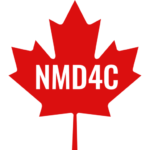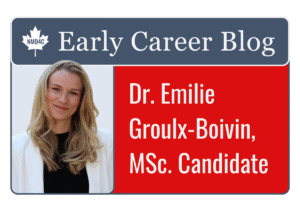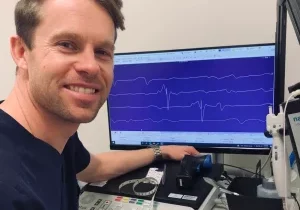Dr. Jeremy Slayter’s Early Career Blog

Dr. Slayter studied Biology at the University of New Brunswick before completing his MD at Dalhousie University in 2023.
He is currently completing his residency in Physical Medicine and Rehabilitation and is enrolled in the clinician investigator program, completing a Master's of Medical Research at Dalhousie University.
His research primarily focuses on clinical measurement of quality of life, function, and other domains of life in neuromuscular diseases to be integrated into research and clinics. The Dr. Patrick Madore Clinical Investigator Traineeship, NMD4C and the Ross Stewart Smith Memorial Fellowship have supported his master’s research.
My Early Career Journey
Researching neuromuscular diseases as a resident physician in Physical Medicine and Rehabilitation and a Master's student at Dalhousie University has taught me about myself, others, and patients.
It’s a journey of learning about science, medicine, and people—and what matters to improve lives.
I’ve learned that quality of life emerges from complex interactions between abilities, goals, and a person’s environment. To better understand quality of life, we must work hard to include patient perspectives in our clinical and research tools. My research focuses on tying together concepts from medicine, psychology, biostatistics and human behaviour to improve and assess clinical measurement techniques of various aspects of life, with a recent focus on patient-reported outcome measures of function and quality of life in Amyotrophic Lateral Sclerosis (ALS) and Spinal Muscular Atrophy (SMA).
Most recently, this journey, supported by the NMD4C Collaborative Research Training Award, took me to the University of Calgary to work with Dr. Gordon Jewett and several of the team members at the Canadian Neuromuscular Disease Registry (CNDR), including Drs. Victoria Hodgkinson and Lisa-Marie Langevin. This collaborative research visit focused on identifying opportunities to advance research capacity together in ALS and SMA. Specifically, we aimed to enhance collaboration and capacity in developing patient-oriented research by aligning our research priorities to work together to improve the clinical measurement of aspects of life that are important to patients.
This goal is an important one. With rapidly advancing treatment discovery and research happening across several neuromuscular diseases, it’s becoming increasingly important to know that neuromuscular clinicians and scientists can assess several different aspects of life that are relevant, comprehensive, and important to patients with enough detail to detect meaningful changes confidently.
If we have better tools, we can improve the ability to accurately identify effective treatments and improve the recognition of changes happening in neuromuscular diseases, ultimately working towards providing better care and improving patient quality of life. By working together, we can leverage each of our strengths to build and test more effective clinical tools to step forward in understanding the lived experiences of persons with neuromuscular diseases.
Beyond our research goals, visiting Calgary gave me a chance to meet with other neuromuscular researchers across the country, as well as to explore parts of Canada that I haven’t seen before, learn about a new city (along with its foods, culture, and sports teams), as well as visit and photograph (see below) one of Canada’s most famous natural wonders, Banff National Park.
Moving forward, I aim to continue to work with patients with neuromuscular disease, to continue to integrate patient experiences into clinical research, and to support further patient voice to guide researchers on the potential multifaceted effects of treatments emerging in neuromuscular diseases.










